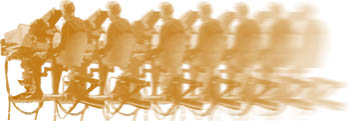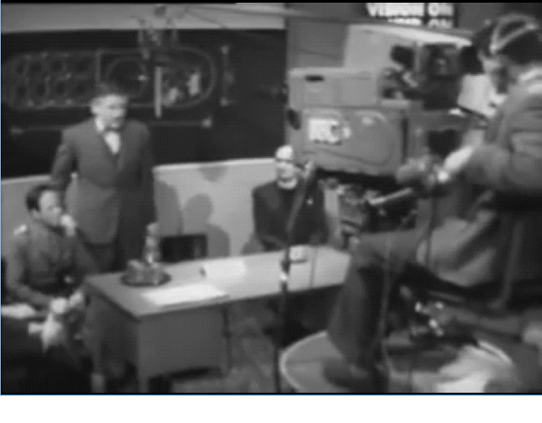
Idly quickly flicking through “Quatermass and the Pit” – as one does – I came across this scene at the end of the last instalment: OK, camera is a Marconi Mk III.
The “Vision On” lights are similar to those I remember from LG when it had the old CPS Emitrons before refurbishment. Did other studios have these?
The cameraman is wearing a jacket – is that just because he will be in shot?
So lots of (other) questions:
| 1. | Studio equipment in shot: were there any previous (drama) programmes by the BBC where the studio equipment (i.e. cameras) were deliberately in shot? There were some later ones, particularly “political” dramas: which ones? |
| 2. | Which Studio is this? |
| 3. | Who is the cameraman (sorry this is the best still I could get). His position looks quite uncomfortable: I’m sure I would have changed the panning handle. |
| 4. | Is there something mounted on the panning handle – seems to have a cable to it… |
| 5. | Which crane is in shot? Query Vinten Motorised? |
| 6. | The cameraman in shot is really wearing cans! What were they? Later STC plastic ones were lighter but didn’t cover the ears so well. |
| 7. | The camera taking this shot was on a crane. Which Crane? (To me it looks like a Mole shot) |
| 8. | Which boom? Query Mole? |
| 9. | The caption stand “in vision” – I guess to represent the caption for the end of the Quatermass interview – is in fact the end caption for the whole programme: |
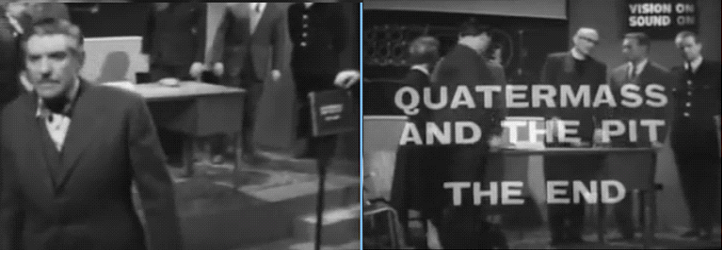
| 10. | Has the end caption or roller caption been in view for any other programme? |
| 11. | There was (in my humble opinion) a reasonably good match between the face tones (and picture gamma) for the film inserts and the studio shots. How was this achieved? Was it just the fact that the CPS Emitron gave good facial tones?br> (On my secondment to Vision Control (which included the last episode of “Compact”!) I always had great difficulty in matching Telecine to the Image Orthicon Studio cameras. |
| 12. | 35mm or 16 mm telerecording? (my guess is 35mm) |
Well, I could go one and on ….
David Brunt
There’s a 1970s “Paul Temple” episode set inside a TV Studio during a TV discussion programme, where everything in studio is seen recording them or idle during off-recording moments. I can’t recall which studio it was – possibly TC3 or TC4.Let’s not forget David Rose managing to get a couple of cameras on screen during the 100th Z Cars episode. Although not part of the drama.
All of “Quatermass and the Pit” was recorded in Riverside 1 (except for the very extensive Ealing film work).
Roger Bunce
“Quatermass and the Pit”: I got the DVD some time ago.You start watching and you think – this is a bit amateur-night by today’s standards: the sets are underdressed; the acting’s a bit theatrical; the camerawork’s bit wobbly, etc. That feeling lasts for about ten minutes, then the atmosphere takes over, and everything else is forgotten. I still think it’s one of the scariest pieces of television drama ever!
Did anyone here work on it?
Bernie Newnham
“Quatermass and the Pit” is on the iPlayer now. It’s a good watch, and there’s a good article about it on Wikipedia – /Quatermass and the Pit.Of course, Tubby Englander gets all the camera credit, and although there was a lot shot at Ealing, they didn’t have to do it live, from Riverside 1. The last scene includes the front of the Mole.
Brian Curtis
As David Brunt says: “…There’s a 1970s Paul Temple episode set inside a TV Studio …”There was indeed! I was on the crew for that – will need to dig out old diary (if I can find it) to find out details of Crew and Date of Recording!
Best bit was that Unions/Equity insisted that we all got “In Vision Appearance” payments! So the 20 Guineas (I think) came in very handy!
David Brunt
It was this one, so I’d assume it was recorded in the first quarter of 1971. I’m not sure how far in advance it was recorded.BBC Genome: 28 March 1971
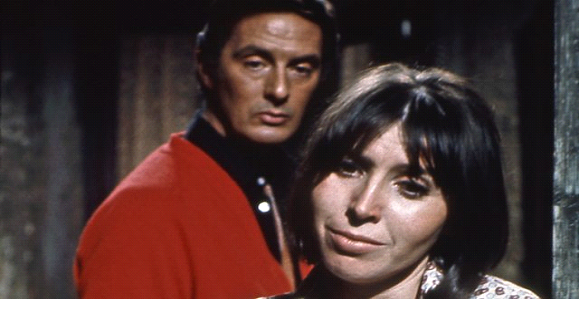
Mike Minchin
I, too, have the Quatermass DVD. I didn’t work on it, but joined the Corporation during the run. I was already hooked on the show, and I remember skiving off a derig so as to see an episode – possibly the last. Either no-one noticed, or someone turned a blind eye – and I did get to see it.Rudi was a bit of a pain to work for. On one occasion he put me onto a Heron, and I had the temerity to ask (“all innocent, like”) why he had chosen that particular mounting. He said “Zis is your Chosen Profession, my boy”. Which I thought was a bit rich coming from someone who had fled the Nazis – and it didn’t answer my query.
I don’t know if it still exists – I think a telerecording was made – but I was an Extra on one of his shows! This was a stage play called “Korzak and the Children” (spelling?), and it had a troop of actors (as actors) performing against a plain cyc. Rudi wanted his production to be demonstrably “…in a Television Studio…” and started with a wide shot with most of the cameras and booms, and Paddy Russell cuing the action. Rudi wanted someone to cross frame, and I, properly cable-bashing, was chosen to do it. On cue, crossed to one of the cameras (already with a cameraman) and pretended to plug my cans in. I was the one person to get an “in shot” fee, as I had to work to a cue!
Peter Neill
There’s a still here, Mike – but I don’t think that’s you.Doctor Korczak and the Children
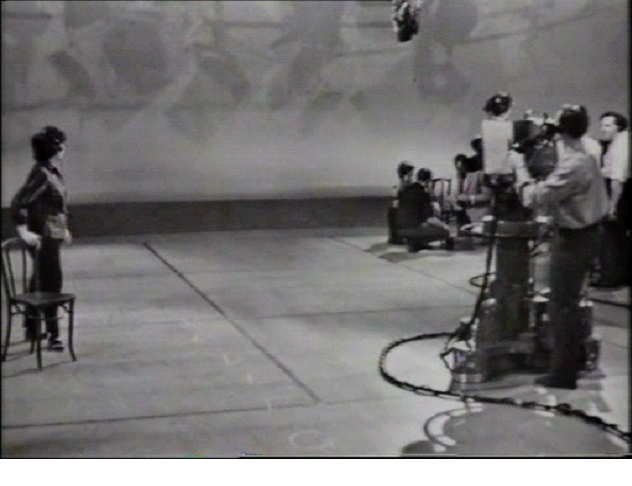
Mike Minchin
You’re right Peter. The still with a camera in it does NOT feature me – I’m not sure who it was. “My” shot was much wider – the length of TC2 – and, as I said, included most of the crew and their equipment. Nice to see Paddy again, especially now she’s gone.Toby Hadoke
My Quatermass quest continues. I’m looking for info on some former BBC employees. they are probably dead but I don’t know that for sure and it never hurts to ask. They all worked on “Quatermass” in the 1950s, and if anyone has any information, no matter how arcane, I would be very grateful.Stuart Mortimer (Production Assistant)
R McCullough (S Tel E – even a first name would be helpful here!)
David Marcus-Roland (Call Boy)
John P Bell (Call Boy)
Preston Bell (Call Boy)
Daphne Martin, later Daphne Ewing (Secretary)
David Ellison (Call Boy)
The mysterious R McCullough is S Tel E (Senior Television Engineer) but what did that job entail exactly please?
As ever, anything even tenuous with regard to Quatermass is very helpful to me … I would be very grateful.
+++++++++++++++++++++++++++++++++++++++++++++++++
Alastair McCullough is R McCullough’s son, and in January 2021, he sent this answer to one of Toby’s questions –
R McCullough was Raymond “Ray” de Budé McCullough, my father, always known as “Ray” at work in Auntie. He worked for the BBC from the late 1930s, based at BBC Television Centre from its opening, until his retirement in around 1973. Raymond rose to the grade of S Com Tech Tel S, or Superintendent Technical Services, looking after about two thousand technical staff, I believe. Before entering management, he had specialised for many years as a lighting engineer since joining Strand Electric as his first job out of school before the BBC.
During the Second World War, Ray worked looking after BBC transmitters at Daventry, a time about which I know very little, except that he was stationed in a Nissen Hut in the Aerial Field for quite a lot of the time and complained about mice leaving footprints in the bacon fat in the frying pan there! The role was exempt from military service since it was supporting the Corporation and the War Effort through broadcasting.
For Quatermass, Ray was the principle lighting engineer, I believe, and told me about the series when I was a boy, speaking of the production with great fondness.
My father was also responsible for lighting The Six-Five Special and a very brief film of him, seen on the studio floor with the camera crew and production team in 1958, appeared in a recent BBC documentary about pop music programmes at the Corporation. As he was lit perfectly, I can only suspect it was made at the time for teaching or publicity purposes!
Raymond wrote a number of books on technical matters for the BBC, and I believe taught at the Corporation’s staff college on occasion. One example was “Lighting and Layout for Small TV Studios”, published in 1969, which amazingly is listed on Amazon: https://www.amazon.co.uk/Lighting-layout-small-TV-studios/dp/B0007J8C1S
Another, which I suspect will be of greater interest, is “Engineering Training Supplement No. 7: Basic Principles of Television Lighting”, written with Ray’s boss at the time, H. O. “Sammy” Sampson: https://www.bbceng.info/additions/2016/No.%207%20-%20Basic%20Principles%20Of%20Television%20Lighting.pdf
Raymond married my mother, Jane McCullough, in 1958 and lived in Buckinghamshire. He retired to Wiltshire in 1983, where he lived very happily with my mother until his death in April 2000.
